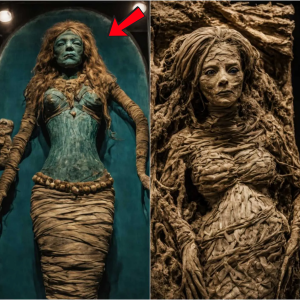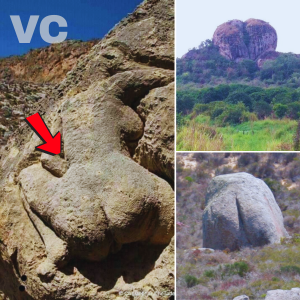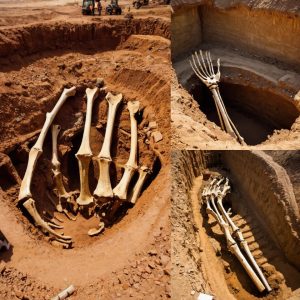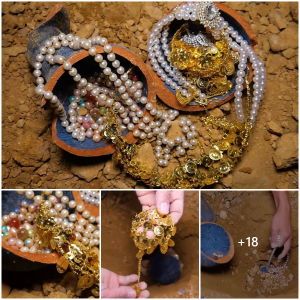The pyramids in Egypt are more famous, but the ones in Sudan hide royal burial sites that archaeologists can explore—as long as they don’t mind swimming.
Archaeologist Pearce Paul Creasman prepares to enter a flooded tomb in the necropolis of Nuri, in Sudan.
I could feel myself suffocating. Each step down the bedrock passageway brought me closer to what I’d long imagined: the pool of khaki water, the flooded tunnel it hid, and the moment I’d have to enter that darkness. The crumbling grandeur of a pyramid loomed above.
Here, at the ancient necropolis of Nuri in Sudan’s northern desert, Kushite royals were laid to rest millennia ago in a series of underground burial chambers beneath mighty pyramids. Now the chambers were flooded with groundwater leaching from the nearby Nile. Archaeologist Pearce Paul Creasman, funded in part by a National Geographic Society grant, was leading a team that would be the first to attempt underwater archaeology below a pyramid. Initially, I’d been calm, even excited, about going along to photograph this ambitious and risky effort, in 2020. But as I walked deeper underground, my heart raced, and I could barely breathe.

The sun breaks the horizon across a view of the Nuri royal cemetery. Its most commanding feature is an arc of some 20 pyramids that appear strung together like gems on a necklace.
I’d known this existential anxiety before. Nine years ago, from crouching in a drainage pipe in Libya as belt-fed machine guns peppered the ground above. Seven years ago, under attack by Al Shabab terrorists in a shopping mall in Nairobi as pop music eerily played on. Four years ago, on a lawless beach in Somalia. Here, there was no outward enemy but something in my own mind screaming at me, Do not descend.
Creasman and dive master Justin Schneider saw my concern. “Give me a moment,” I said. Holding tightly to my camera, a weight belt slung across my chest, I bit into my regulator and sank cross-legged below the waterline. Breathe. Just breathe.
Surfacing, I nodded to my companions: I was ready. We descended, funnelling ourselves through a narrow chute and down into the disorienting blackness.

Creasman uses innovative underwater archaeology techniques to save parts of Nuri’s history that otherwise would have been lost once Nile waters submerged parts of the necropolis.
Every culture of the world has death traditions, to ease the passage of loved ones into the next life and soothe those left behind in this one. This 2,300-year-old tomb was the resting place of Nastasen, a king who led Kush for roughly two decades. Before him, several of the Kushite kings, known as Black pharaohs, became so powerful that they ruled all of Nubia and Egypt. Nastasen was the last of them to be buried at Nuri before threats from rivals forced the Kush to move their capital south. They left behind extraordinary temples, pyramids—and their interred pharaohs.

Workers clear rubble off the 2,300-year-old pyramid that marks the tomb of Nastasen, who ruled Kush for roughly two decades and was the last king buried at the Nuri site.
Excavating Nuri, with its treasures hidden underwater, was an especially formidable challenge. A century ago, Harvard Egyptologist George Reisner visited Nuri to explore, among others, the burial chamber of King Taharqa, who ruled all of Egypt in the seventh century B.C. and even earned a mention in the Old Testament for rallying his troops to defend Jerusalem.
Many of the other Nuri tombs, though, were left unexplored. The waters have since risen higher, influenced by climate change, the growing agricultural needs of the area, and the modern dams that are transforming the Nile.
Since Creasman’s work began, Sudan has experienced a coup, a global pandemic, record-setting floods, and a 2019 revolution. When protesters toppled the 30-year dictatorship of Omar al Bashir—whose government tried to erase Sudan’s pre-Islamic history—they chanted the names of Nubian royals: “My grandfather is Taharqa, my grandmother is a kandaka (queen)!” Bashir is now facing charges at the International Criminal Court. Protesters in the streets denounce the military that grabbed power and sabotaged the country’s democratic transition. History long submerged has begun to surface.

Archaeologist Gretchen Emma Zoeller excavates a burial site of an adult female in Nuri, an ancient necropolis that spans more than 170 acres of desert near the east bank of the Nile River in northern Sudan.
I swam through a dark channel into the tomb’s chambers. Clouds of sediment obstructed all visibility, and despite the small space, it was shockingly easy to get lost and find yourself swimming in circles. A hand connected with mine, and we emerged into the second chamber, where the collapsed ceiling resulted in a welcome air pocket. By flashlight, work began.
Traditional dirt-excavation skills were useless here, so Creasman’s team had to develop new techniques—often on the fly—to uncover the secrets of this overlooked kingdom. Underwater archaeology is now a specialised field, but in its early days, the skills and tools were adapted from shipwreck salvagers and rarely had been used in such tight confines.
No room for bulky scuba tanks either, obviously. We breathed instead through sunshine yellow hoses that ran back the way we entered, connecting us to the air above. The risk of a cave-in couldn’t be absolutely eliminated, but the entrance was reinforced with 50 linear feet of steel beams, and risk was just not talked about much. Team members looked for anything of interest—gold leaf, figurines, pottery—and noted their findings with waterproof boards and markers. A thin cord ran from the third and final burial chamber to the world above, our guide through the darkness.
The work acquired a rhythm. Creasman would descend into the final chamber, which held what might have been Nastasen’s unopened sarcophagus. A few minutes later, he’d return with a filled bucket; it would be carried outside to team members who’d examine and sort its contents.

Creasman and dive master Justin Schneider scuba dive to explore burial chambers at Nuri, now submerged as a result of modern climate change, agricultural activity, and the construction of dams.

Discoveries in the flooded necropolis include shabtis, funerary figures intended to serve the king in the afterlife.
About an hour into this routine, Creasman surfaced in the second chamber, took a breath, and called out, “Shabti!” He tenderly lifted the funerary figurine for us to see. Gazing at it in his palm, I realised my breath had slowed to normal and my mind had cleared. The carved man was broken down the middle but retained his dignified, dutiful expression. He looked ready to fulfil his destiny. Thousands of years ago—a span so long I can’t really fathom it—the figures were believed to revive in order to serve their masters in the afterlife. Now here I was, in the underworld with them. My fear washed away, and awe flooded in.
In my line of work I’ve had a few opportunities like this: to experience an ancient marvel as most people never will and to photograph it for the world to see. I focused on the glistening-wet shabti; the camera shutter blinked, making the ephemeral permanent.

Helmets worn by Creasman and Schneider lay out to dry in the hot sun after a day of scuba diving in royal burial sites.
Nastasen had rested here in darkness for two millennia, kept company by hundreds of tiny caretakers. Soon I’d return to the world above ground, with its impossibly blue skies. But not yet. First, I shot frame after frame, freezing this place in time and willing myself to remember those things beyond my ability to capture.





